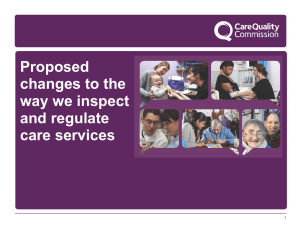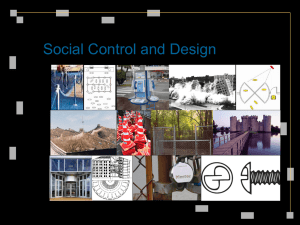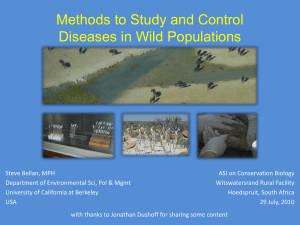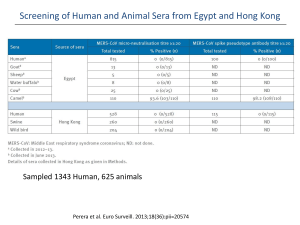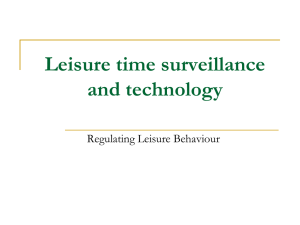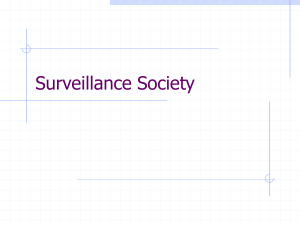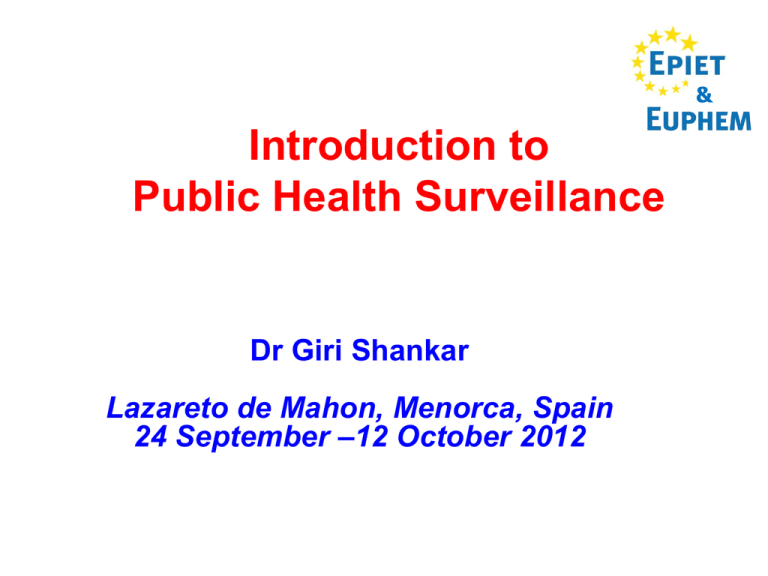
&
Introduction to
Public Health Surveillance
Dr Giri Shankar
Lazareto de Mahon, Menorca, Spain
24 September –12 October 2012
Surveillance Track
&
6 Lectures; 2 case studies
Mon 24 Sept – Introduction to PH surveillance
Tue 25 Sept – Event based surveillance
Wed 26 Sept
• Key elements of a surveillance system ( I & II)
• Analysis of surveillance data
Fri 28 Sept – Evaluation of surveillance system
2
Outline of Lecture
&
Definition of Surveillance
Surveillance Loop
Uses of Surveillance with examples
Summary
3
What is Surveillance?
Could you drive without looking at the
traffic?
&
Can you make public health
decisions in the absence of
data?
The systematic process of collection, transmission,
analysis and feedback of public health data for
decision making
4
Definitions of surveillance
&
“The continued watchfulness over the distribution and trends in the incidence of
disease through the systematic collection, consolidation and evaluation of morbidity
and mortality reports and other relevant data”
Alexander Langmuir, Chief Epidemiologist, CDC
“Continuous analysis, interpretation and feedback of systematically collected data,
generally using methods distinguished by their practicality, uniformity and rapidity,
rather than by accuracy and completeness”
WJ Eylenbosch & ND Noah (eds). Surveillance in Health and Disease. Oxford University Press 1988.
”The systematic ongoing collection, collation and analysis of data for public health
purposes and the timely dissemination of public health information for assessment
and public health response as necessary.”
World Health Assembly 2005
5
&
Surveillance
is
Information for action
6
The surveillance loop
Health care
system
&
Surveillance
centre
Event
Data
Planning,
Evaluation,
Policy formulation
Action
Analysis,
interpretation
Reporting
Information
Feedback,
recommendations
7
Source: S Hahne, S Cotter, D Werker - EPIET
Event and population
under surveillance
Event
&
Population and time
Disease
Syndrome
Acute flaccid paralysis
Influenza-like illness
Diarrhoea
Infection
• Everyone in the country or region
• Patients in hospitals
• Employees in a factory
Public health issue
Antimicrobial resistance
• All children in the winter months
Environment
Vector population
Water quality
8
The surveillance loop
Health care
system
&
Surveillance
centre
Event
Data
Planning,
Evaluation,
Policy formulation
Action
Analysis,
interpretation
Reporting
Information
Feedback,
recommendations
9
Source: S Hahne, S Cotter, D Werker - EPIET
Surveillance methodskey data items collected
&
Numerators
-
number of cases of disease
-
antibody positive samples
-
number of resistant strains
Descriptors
-
characteristics of patients, strains etc
Denominators
-
total population at risk (or sub-sample) in a given time frame
-
total number of strains examined
10
Case definition
&
YES
NO
A case is an event
A case is not a person
An event is something
that happens to:
Events do not exist if
you lack info:
A person,
On the person
In a given place,
On the place
At a given time
On the onset date
A case definition is a set
of criteria that triggers
reporting
A case definition is not a
diagnosis made to
decide treatment
11
Case definition
Includes:
Should be:
• Time, place, person
• Clear, simple
&
• Clinical features
and /or
Field tested
• Laboratory results
• Stable and valid
and/or
• Epidemiological features
12
Case definition
Possible case
&
Clinical diagnosis of meningitis or septicaemia or other invasive disease where the
CCDC/CPH, in consultation with the clinician and microbiologist, considers that
diagnoses other than meningococcal disease are at least as likely
Probable case
Clinical diagnosis of meningitis or septicaemia or other invasive disease where the
CCDC/CPH, in consultation with the physician and microbiologist, considers that
meningococcal infection is the most likely diagnosis
Confirmed case
Clinical diagnosis of meningitis, septicaemia or other
invasive disease
AND at least one of:
• Neisseria meningitidis isolated from normally sterile site
• Gram negative diplococci in normally sterile site
• Meningococcal DNA in normally sterile site
• Meningococcal antigen in blood, CSF or urine.
13
Reporting (data transfer)
&
Data transfer method
Individual data
•
•
•
•
• Identified – name, personal id number
Paper by mail
Telephone
E-mail
Secure Internet
• Non-identified – but possible to trace
back
• Anonymous – impossible to trace back
Data transfer frequency Aggregated data
•
•
•
•
For every case
Daily
Weekly
Quartery
• Numbers
• Tabulated numbers – by sex, age
group etc
14
The surveillance loop
Health care
system
&
Surveillance
centre
Event
Data
Planning,
Evaluation,
Policy formulation
Action
Analysis,
interpretation
Reporting
Information
Feedback,
recommendations
15
Source: S Hahne, S Cotter, D Werker - EPIET
Surveillance data sources
&
Generic sources
- Notifications of infectious diseases
- Microbiology laboratory reports
- Hospital Episode Statistics
- Primary Care spotter practices
- Screening programmes (antenatal, blood donors)
- Prescriptions / over the counter drug sales
16
Surveillance data sources
&
Disease or patient specific sources
- Customised surveillance programmes
∙ voluntary e.g. HIV/AIDS surveillance
∙ mandatory e.g. Clostridium difficile
∙ enhanced e.g. meningococcal disease
- Patient registers e.g. renal registry
- Clinical networks e.g. British Paediatric Surveillance Unit (BPSU)
Non health sources
- Veterinary medicine domestic & wild animals, animal husbandry
- Environment health water, food, air sampling
- Population statistics e.g. death registrations
17
The surveillance loop
Health care
system
&
Surveillance
centre
Event
Data
Planning,
Evaluation,
Policy formulation
Action
Analysis,
interpretation
Reporting
Information
Feedback,
recommendations
18
Source: S Hahne, S Cotter, D Werker - EPIET
Analysis of surveillance data
&
Descriptive use
Measure of disease frequency
- incidence (no. cases/population at risk over given time period)
e.g. 5 cases per 1000 person years; 0.3 cases per 1000 bed-days
- prevalence (no. cases/population at risk at a set time)
e.g. 15% of patients sampled antibody positive; 3% strains erythromycin resistant
Data described according to time-person-place
Analytical use
Comparison between groups to gain a measure of increased risk
e.g. case fatality in males vs females
e.g. change in rate of infection over time
19
&
Surveillance
is
Information for action
20
Purposes and uses of
surveillance
• describe the disease and its importance
&
what is the problem?
• monitor secular trends
• detection of outbreaks & emerging epidemics
• monitor health practices
how do we deal with it?
• monitor changes in infectious agents
did it work?
• provide an evidence base for policy and guidance formulation
• monitor control and prevention measures
• generate hypotheses and stimulate public health research
how can we do better?
21
Purposes and uses of surveillance
&
• describe the disease and its importance
•
•
•
•
•
•
•
monitor secular trends
detection of outbreaks & emerging epidemics
monitor health practices
monitor changes in infectious agents
provide an evidence base for policy and guidance formulation
monitor control and prevention measures
generate hypotheses and stimulate public health research
22
Notifications of Meningococcal Infections
&
No of cases
Cases of group B and C meningococcal disease in England and Wales,
by age group -1998-2004
Year
23
Purposes and uses of surveillance
&
• describe the disease and its importance
• monitor secular trends
•
•
•
•
•
•
detection of outbreaks & emerging epidemics
monitor health practices
monitor changes in infectious agents
provide an evidence base for policy and guidance formulation
monitor control and prevention measures
generate hypotheses and stimulat public health research
24
TB notification and death rate
England and Wales, 1913 - 2000
&
Year
25
Purposes and uses of surveillance
&
• describe the disease and its importance
• monitor secular trends
• detection of outbreaks & emerging epidemics
•
•
•
•
•
monitor health practices
monitor changes in infectious agents
provide an evidence base for policy and guidance formulation
monitor control and prevention measures
generate hypotheses and stimulate public health research
26
UK epidemiology: containment phase
RCGP weekly ILI rate 2009/10 and recent years.
ILI rate per 100 000
250
2008/09
1999/2000
Baseline*
2007/08
2009/10
Epidemic threshold*
200
150
100
First UK cases
detected
50
0
19-Apr 31-May 12-Jul 23-Aug 04-Oct 15-Nov 27-Dec 07-Feb 21-Mar
Week-ending date
* Baseline activity<30 per 100,000; epidemic activity>200 per 100,000
27
&
No of cases
Age and sex distribution of confirmed
H1N1v cases in the UK, 30 June 2009
(n= 6766)(FluZone)
Age Group (yrs)
28
Regional Spread of cases - May
&
10 May
31 May
29
Regional spread of cases - June
&
12 June
05 June
26 June
19 June
30
UK epidemiology: treatment phase
&
RCGP weekly ILI rate 2009/10 and recent years, England
2008/09
1999/2000
Baseline*
ILI rate per 100 000
250
2007/08
2009/10
Epidemic threshold*
200
150
100
50
Switch to
'treatment
only' phase
First UK
cases
detected
0
19-Apr 31-May 12-Jul 23-Aug 04-Oct 15-Nov 27-Dec 07-Feb 21-Mar
Week-ending date
* Baseline activity<30 per 100,000; epidemic activity>200 per 100,000
31
UK epidemiology: launch of National
Pandemic Flu Service
&
RCGP weekly ILI rate 2008/09 and recent years, England
ILI rate per 100 000
250
200
150
100
50
2008/09
1999/2000
Baseline*
2007/08
2009/10
Epidemic threshold*
NPFS Launched and
Schools close for summer
Switch to
'treatment
only' phase
First UK
cases
detected
0
19-Apr 31-May 12-Jul 23-Aug 04-Oct 15-Nov 27-Dec 07-Feb 21-Mar
Week-ending date
* Baseline activity<30 per 100,000; epidemic activity>200 per 100,000
32
UK epidemiology: end of first wave
&
RCGP weekly ILI rate 2009/10 and recent years.
ILI rate per 100 000
250
200
150
100
50
2008/09
1999/2000
Baseline*
2007/08
2009/10
Epidemic threshold*
NPFS Launched and Schools
close for summer
Switch to
'treatment
only' phase
First UK
cases
detected
schools
re-open
0
19-Apr 31-May 12-Jul 23-Aug 04-Oct 15-Nov 27-Dec 07-Feb 21-Mar
Week-ending date
* Baseline activity<30 per 100,000; epidemic activity>200 per 100,000
33
UK epidemiology: end of first wave
&
&
RCGP weekly ILI rate 2009/10 and recent years.
ILI rate per 100 000
250
200
150
100
50
2008/09
1999/2000
Baseline*
2007/08
2009/10
Epidemic threshold*
NPFS Launched and Schools
close for summer
Switch to
'treatment
only' phase
First UK
cases
detected
schools
re-open
School
half-term
break
0
19-Apr 31-May 12-Jul 23-Aug 04-Oct 15-Nov 27-Dec 07-Feb 21-Mar
Week-ending date
* Baseline activity<30 per 100,000; epidemic activity>200 per 100,000
34
Purposes and uses of surveillance
&
• describe the disease and its importance
• monitor secular trends
• detection of outbreaks & emerging epidemics
• monitor health practices
•
•
•
•
monitor changes in infectious agents
provide an evidence base for policy and guidance formulation
monitor control and prevention measures
generate hypotheses and stimulate public health research
35
Bi
le
Ab
do
m
ia
liv
lh
er
ys
or
te
C
p
or
re
a
on
nc
ct
om
re
ar
at
y
y
Ar
ic
te
su
ry
rg
By
er
y
pa
ss
G
G
as
ra
To
tri
ft
c
ta
su
lh
rg
ip
er
r
ep
y
H
ip
la
ce
he
m
m
en
ia
rth
t
Kn
ro
pl
ee
as
re
ty
La
pl
ac
rg
em
e
bo
en
w
t
el
s
Li
O
ur
m
pe
ge
b
n
ry
a
re
m
du
pu
ct
ta
io
tio
n
n
Sm
of
fra
al
lb
ct
ur
ow
e
el
su
Va
rg
sc
er
ul
y
ar
su
rg
er
y
du
ct
,
Distribution of surgical site infection by
category of surgical procedure
Oct 1997 - Dec 2003
&
25
20
15
10
5
0
36
Purposes and uses of surveillance
•
•
•
•
&
describe the disease and its importance
monitor secular trends
detection of outbreaks & emerging epidemics
monitor health practices
• monitor changes in infectious agents
• provide an evidence base for policy and guidance formulation
• monitor control and prevention measures
• generate hypotheses and stimulate public health research
37
Staphylococcus aureus bacteraemia reports
and methicillin susceptibility England & Wales
&
17,500
resistant
number of reports
15,000
12,500
no information
sensitive
10,000
7,500
5,000
2,500
0
38
Purposes and uses of surveillance
•
•
•
•
•
&
describe the disease and its importance
monitor secular trends
detection of outbreaks & emerging epidemics
monitor health practices
monitor changes in infectious agents
• provide an evidence base for policy and guidance
formulation
• monitor control and prevention measures
• generate hypotheses and stimulate public health research
39
Number of new HIV diagnoses¹ by prevention group²,
UK: 1999-2008
4,500
4,000
New HIV diagnoses
3,500
&
MSM
Heterosexual contact in the UK
Heterosexual contact abroad
IDU
Blood product recipients
Mother-to-child transmission
3,000
2,500
2,000
1,500
1,000
500
0
1999
2000
2001
2002
2003
2004
2005
2006
2007
2008
¹ Numbers will rise as further reports are received, particularly for recent years
² Adjustments made for missing information relating to patient exposure
MESH Department - Centre for Infections
40
Purposes and uses of surveillance
•
•
•
•
•
•
&
describe the disease and its importance
monitor secular trends
detection of outbreaks & emerging epidemics
monitor health practices
monitor changes in infectious agents
provide an evidence base for policy and guidance formulation
• monitor control and prevention measures
• generate hypotheses and stimulate public health research
41
Laboratory confirmed serogroup
C meningococcal disease
&
start of routine
immunisation and
catch up (15-17y, <1y)
end of catchup
Source: Meningococcal Reference Unit/CfI
42
Cumulative reports of Pneumococcal
Disease due to the seven serotypes IN
Prevenar™ : Children < 2 Years in E&W
by Epidemiological Year
&
43
Cumulative reports of Pneumococcal
Disease due to the seven serotypes NOT in
Prevenar™ : Children < 2 Years in E&W by
Epidemiological Year
&
44
Purposes and uses of surveillance
•
•
•
•
•
•
•
&
describe the disease and its importance
monitor secular trends
detection of outbreaks & emerging epidemics
monitor health practices
monitor changes in infectious agents
provide an evidence base for policy and guidance formulation
monitor control and prevention measures
• generate hypotheses and stimulate public health
research
45
MRSA bacteraemia in children
&
proposal to undertake enhanced surveillance of
MRSA in children
46
Summary
&
Surveillance is a lively line of communication that works
both ways
A surveillance system counts the same events,
consistently, every day
Surveillance directs decision-making
47
Remember
&
Surveillance
is
Information for action
48

